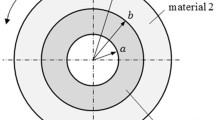A layer-by-layer method of stress calculation in symmetrical pairs of layers is proposed to estimate the bearing capacity of composite pressure vessels, for which simple criteria of biaxial tensile strength of composite pipes are substantiated. According to the model of a diamond-shaped (rhombus) assembly of inextensible fibers, the limiting surface in the stress space represents a rectangle. Stresses corresponding to the points on the sides of this rectangle determine the conditions of different types of failure: matrix cracking or fiber bursting. The limiting surface can be described by a single equation of an inclined ellipse. We propose a simple method for constructing the limiting surface for a pair of symmetrically wound layers based on only two values of winding strength (0) and (+45°) under uniaxial axial tension. Comparison of the calculated stresses with the ultimate surface for each pair of layers allows one to formulate the optimal design problem in terms of equality of safety factors for each pair of layers.




Similar content being viewed by others
References
N. A. Alfutov, P. A. Zinoviev, and V. G. Popov, Calculation of Multilayer Plates and Shells of Composite Materials [in Russian], Mashinostroenie, Moscow (1984).
C. Huang, M. Ren T. Li, et al., “Trans-scale modeling framework for failure analysis of cryogenic composite tanks,” Compos. Part B-Eng., 85, 41–49 (2016), https://doi.org/10.1016/j.compositesb.2015.09.023.
D. M. Grogan, C. M. Ó. Brádaigh, J. P. McGarry, and S. B. Leen, “Damage and permeability in tape-laid thermoplastic composite cryogenic tanks,” Compos. Part A-Appl. S., 78, 390–402 (2015), https://doi.org/10.1016/j.compositesa.2015.08.037.
Yu. S. Solomonov, V. P. Georgievskii, A. Ya. Nedbai, and V. A. Andryushin, Calculation Methods for Cylindrical Shells of Composite Materials [in Russian], Fizmatlit, Moscow (2009).
V. N. Bakulin, Methods for Optimal Design and Calculation of Composite Structures [in Russian], Vol. 1: Optimal Design of Structures from Composite and Traditional Materials, Fizmatlit, Moscow (2008).
O. Yu. Sklemina, N. A. Tatus’, and A. N. Polilov, “Analytical and finite element method of calculation of multi-shell gas tanks,” IOP Conf. Ser.: Mater. Sci. Eng., 747, 012131 (2020), https://doi.org/10.1088/1757-899X/747/1/012131.
A. K. Malmeister, “Geometry of strength theories,” Mekh. Polimer., No 4, 519–534 (1966).
A. K. Malmeister, V. P. Tamuzh, and G. A. Teters, Resistance of Rigid Polymeric Materials [in Russian], Zinatne, Riga (1967).
V. L. Bazhanov, I. I. Goldenblat, V. A. Kopnov, et al., Resistance of Glass Plastics [in Russian], Khimiya, Moscow (1968).
S. W. Tsai and E. M. Wu, “A general theory of strength for anisotropic materials,” J. Compos. Mater., 2, No. 1, 191–206 (1971), https://doi.org/10.1177/002199837100500106.
E. Wu, Phenomenological Anisotropic Failure Criterion, in: Composite Materials, Vol. 2: G. P. Sendeckyj (Ed.), Mechanics of Composite Materials, Ch. 9, Academic Press (1974).
A. Rotem and Z. Hashin, “Failure modes of angle-ply laminates,” J. Compos. Mater., 9, No. 1, 58–67 (1975), https://doi.org/10.1177/002199837500900209.
Z. Hashin, “Failure criteria for unidirectional fiber composites,” J. Appl. Mech., 47, 329–334 (1980), https://doi.org/10.1115/1.3153664.
Yu. N. Rabotnov, “About strength of composites reinforced in two directions,” Mekh. Polimer., No. 5, 832–834 (1978).
A. N. Polilov, “Scheme of calculation of strength of obliquely reinforced composites under flat stressed state,” Mekh. Kompoz. Mater., No. 2, 221–226 (1980).
A. N. Polilov and N. A. Tatus’, “Experimental substantiation of strength criteria of fibrous composites exhibiting directional fracture character,” Vestn. PNIPU. Mekhanika, No. 2, 140–166 (2012).
A. N. Polilov, Experimental Mechanics of Composites. Textbook [in Russian], Bauman MSTU, Moscow (2015).
M. M. Martirosyan, “Strengthening of oriented glass-reinforced plastics under biaxial tension,” Mekh. Polimer., No. 6, 1025–1029 (1976).
Yu. N. Rabotnov, I. N. Danilova, A. N. Polilov, et al., “Investigation of strength of winding epoxy carbon and glass plastics in torsion, tension and transverse bending,” Mekh. Polimer., No. 2, 219–225 (1978).
G. C. Eckold, D. Leadbetter, P. D. Soden, and P. R. Griggs, “Lamination theory in the prediction of failure envelopes for filament wound materials subjected to biaxial loading,” Composites, 9, No. 4, 243–246 (1978), https://doi.org/10.1016/0010-4361(78)90176-3.
P. D. Soden, D. Leadbetter, P. R. Griggs, and G. C. Eckold, “The strength of a filament wound composites under biaxial loading,” Composites, 9, No. 4, 247–250 (1978), https://doi.org/10.1016/0010-4361(78)90177-5.
A. A. Lebedev, A. V. Boiko, and N. R. Muzyka, “Method of testing materials in uniform biaxial tension,” Strength Mater., 14, No. 2, 252–254 (1982), https://doi.org/10.1007/BF00769069.
I. Lapczyk and J. A. Hurtado, “Progressive damage modeling in fiber-reinforced materials,” Compos. Part A-Appl. S., 38, 2333–2341 (2007), https://doi.org/10.1016/j.compositesa.2007.01.017.
M. V. Kozlov and S. V. Sheshenin, “Modeling the progressive failure of laminated composites,” Mech. Compos. Mater., 51, 695–706 (2016), https://doi.org/10.1007/s11029-016-9540-0.
K. Hoos, E. V. Iarve, M. Braginsky, et al., “Static strength prediction in laminated composites by using discrete damage modeling,” J. Compos. Mater., 51, 1473–1492 (2017). https://doi.org/10.1177/0021998316651986.
H. Zhu, Z. X. Guo, M. Zhu, et al., “A progressive FE failure model for laminates under biaxial loading,” Mech. Compos. Mater., 56, 207–214 (2020), https://doi.org/10.1007/s11029-020-09873-7.
Author information
Authors and Affiliations
Corresponding author
Additional information
Translated from Problemy Prochnosti, No. 5, pp. 79 – 88, September – October, 2021.
Rights and permissions
About this article
Cite this article
Polilov, A.N., Vlasov, D.D., Sklemina, O.Y. et al. Strength Criteria of Obliquely Wound Composite Tubes Under Biaxial Tension. Strength Mater 53, 765–774 (2021). https://doi.org/10.1007/s11223-021-00342-7
Received:
Published:
Issue Date:
DOI: https://doi.org/10.1007/s11223-021-00342-7




